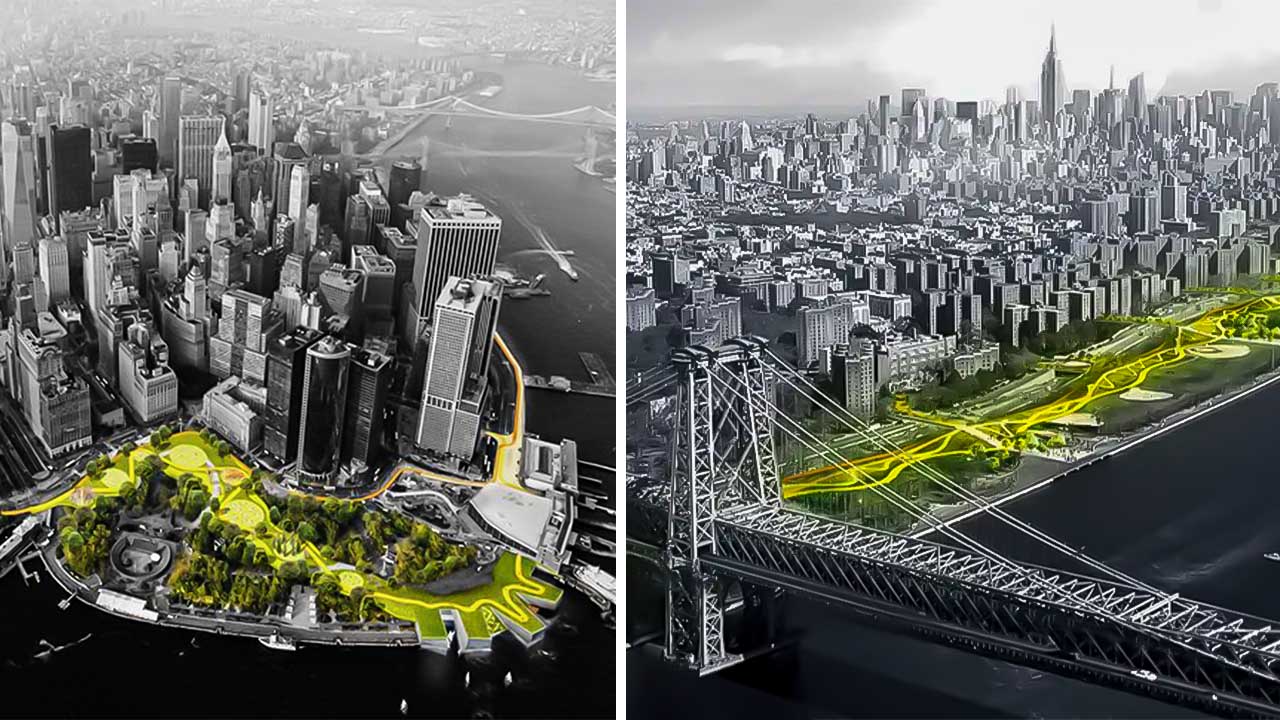The $119 Billion New York Sea Wall to Protect the City
Hardly any region of the world has been spared from the negative effects of climate change. For more than a decade, droughts, heavy rains and floods have affected daily life and caused economic losses of millions of dollars.
While measures are being taken in various countries to deal with possible climate disasters, a comprehensive plan has also been started to protect the coastal areas of New York from the dangers of hurricanes in the future.
New York, which was the capital of the United States of America from 1785 to 1790, and whose densely populated borough Manhattan is one of the most important commercial, financial and cultural centers of the world, has been under the influence of climate change for more than a decade.
Hundreds of thousands of buildings in the city, skyscrapers like One World Trade Center and Central Park Tower, and millions of people are in serious danger due to the heavy rains that occur every year.
Hurricane Sandy in 2012 caused 60 deaths and over $70 billion in damage. According to the National Ocean Service, sea levels are expected to rise by one foot or a quarter of a meter by the year 2050. Before it’s too late, New York must be saved.
The modern city of New York was established in 1898, consisting of the five boroughs of Manhattan, the Bronx, Brooklyn, Queens and Staten Island. If you travel to the west side of Manhattan, you will reach the Battery Park City area. Located in the extreme south of New York, this 92-acre area was settled in the 1960s under land reclamation. Battery Park, located along the Hudson River, is considered a successful urban renewal project with green spaces, restaurants, residential buildings, and commercial buildings, including the Brookfield Place shopping center near the World Trade Center.
All of New York was affected by Hurricane Sandy in 2012, but the most densely populated area of lower Manhattan was plunged into darkness for days by severe flooding, with streets overlooking the river. Most of the homes and critical infrastructure were destroyed, resulting in an estimated $19 billion cost to the region.
Also Read: Building the New Saudi Arabia: Vision 2030’s Saudi Mega Projects
Climatologists say that lower Manhattan may experience more severe storms and flooding in the future due to climate change and that the city’s infrastructure may not be able to cope. Water levels in the Battery Park area may rise by 5 to 7 meters during future storms. Climate Central, a nonprofit organization, says New York is the country’s most vulnerable city by population and that the city’s area at risk will continue to grow as global warming increases.
In early 2023, the US Army Corps of Engineers proposed a $52.6 billion plan to protect New York from coastal storms. Under New York Sea Wall project, sea walls 12 to 20 feet high and 50 miles long will be built in the city. It was the most expensive project ever proposed by the Corps so far.
Plan 3B, tentatively chosen to address the problem, has been scrutinized for spending about $18 billion on breakwaters and seawalls and more than $14 billion on levees and floodwalls, among many other changes. According to the Army Corps of Engineering, 65% of the funding for this project will be provided by federal resources, while 35% will be provided by the states of New York and New Jersey.
While the project was praised, it was also criticized by some experts who said that the view of the sea from the Battery Park area would be blocked due to the project. The Hudson Greenway and Long Island’s vast expanse of greenery will be overlooked.
According to New York City’s chief climate officer, changing the landscape will not limit the ocean to the bay, nor will the coast look the same. However, while preparing for climate change, city residents don’t want to miss out on waterfront activities, ferry systems and scenic views.
Despite the higher cost, the Army Engineering Corps’ proposed plan would still leave about 40% of the area vulnerable to coastal flooding. This is likely due to a cost-benefit approach that appears to be allegedly biased against protecting smaller communities with lower incomes or lower property values.
On the other hand, at least a $220 million project is currently being considered to mitigate the effects of flooding in the Battery Park area. The project includes the 3.5 acre Wagner Park area on the waterfront, which is 3 meters above sea level. According to the plan, after demolishing this park, its elevation will be increased by 3 meters above the sea level. The move will be made possible by a reinforced flood wall, buried under the park, while other sections will be topped with reinforced glass.
Unlike a traditional sea wall that would divide the area, the buried wall would provide tourists with ample opportunity to access more green areas. The above-ground portion of these New York Sea Walls will contain gates that will remain hidden from the eyes of visitors when not in use.
The chain will be expanded to the north of the area to Tribeca, an area of old industrial buildings, houses and trendy boutiques, where Washington Market Park and Hadron River Park are located. An additional flood barrier system will be installed on the shore side.
Also Read: Hyper Kamiokande: Japan is building Something Huge Inside a Mountain
The drainage system will also be expanded with isolation valves and tide gates under the project. At the lowest point of the area, a double-level landscape design will be arranged, which will act as a barrier against rising water. Seats for the visitors will be made of wood which will not get damaged even after being submerged in water for a long time. A concrete wall will be constructed to resist the salt water of the sea and trees will also be planted.
New York Sea Wall project will help protect the area and the surrounding population from high sea levels, storm surges and floods in extreme weather conditions. In this way, it will be possible to be safe from the economic losses in addition to the normal life here in the next possible storm.
New York Sea Wall project can be considered effective, but the people of different areas of the city and especially Wagner Park have found it unacceptable. Local advocates say they agree with officials that New York needs to be protected from rising sea levels, but the proposed project would result in a 10% loss of green space in the form of tree destruction and changes to parks structures.
In fact, in a busy, commercial and densely populated city like New York, green spaces are rare. In response to all such objections, the authorities have re-examined the initial plan and made several changes, but for many, these changes are not enough.
A few individuals have also provided alternative plans to deal with these problems, including extensive floodwalls and measures to protect existing buildings from flooding. However, many citizens agree that raising the park above sea level would be beneficial to avoid flooding during future storms.
Building flood walls would require costly changes to New York’s drainage system, while modern pumping stations would be necessary to protect neighborhood on the other side of the walls from flooding.
In other cities facing such threats, such as Rotterdam, London, Venice and St. Petersburg, rows of moving gates have been installed at the main entrances to ports. Global experts say this approach is highly efficient and reliable, allowing large areas to be protected while leaving the coastline free for recreation and other uses. Such a plan, they say, is an ideal fit for the geography of New York’s coastal areas.
Climate change, extreme weather conditions and hurricanes have become a problem in every region of the planet, especially in the northern hemisphere. What do you think are other ways to avoid global warming apart from improving the climate by planting trees?







